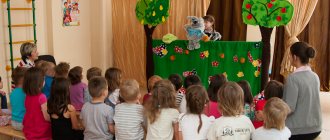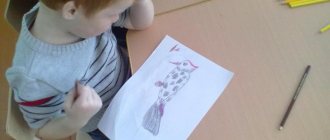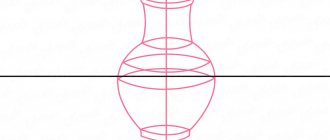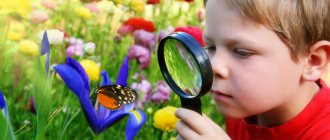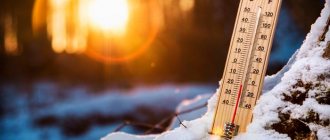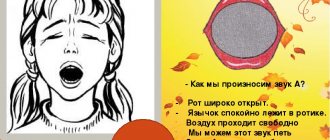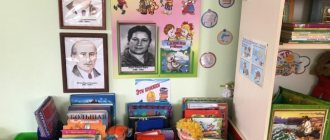A new cycle begins - observing a parrot in a corner of nature.
Observation. “How many wings do birds have and how do they fly?”
Goal: to clarify children’s ideas about the two methods of movement of birds in space, about their structure (legs and wings), about the features of the wings (they open - and then are clearly visible, fold and press against the body - in this case they are invisible, birds fly through the air with the help of open wings - they flap them, push off from the air and fly; a person does not have wings, he cannot fly).
The teacher organizes observation at the moment when flying birds appear in the sky. Invites children to depict the flight of birds. Discusses with them what a bird looks like in flight and on the ground, why birds fly but humans don’t.
In his free time, the teacher reads to those who want to, E. Charushin’s story “How the boy Zhenya learned to say the letter “r.” After reading, he talks to the children about crows: how they walk, how they fly, how they croak. He asks each child to croak - he finds out who should learn to say “r” just like Zhenya.
A cycle of observations of a parrot living in a corner of nature begins (if another bird lives in the group, the teacher, by analogy, himself creates a cycle of observations).
Observation 1. “How is a parrot different from sparrows?”
Goal: to clarify children’s ideas about the characteristic features of the appearance of a parrot, about the structure of its body, and to teach comparison techniques.
The teacher invites everyone who wants to look at the parrot and say what it is like, what it has (head, tail, legs, eyes, beak). Then he asks to remember the sparrows that fly to the feeder, to say what they are like, how they differ from a parrot. If preschoolers find it difficult to answer, the teacher shows a color picture of sparrows, asks them to look at it and at the parrot and say how the birds are different from each other.
In conclusion, the teacher himself sums it up: “These birds are not only different, but they are also similar to each other. Both sparrows and parrots have one head, one tail, two legs, two wings. What else do they have the same? Of course, both sparrows and parrots are birds, so they are similar to each other.”
Observation 2. “What and how does a parrot eat?”
Goal: to clarify children’s ideas about the structural features of a parrot’s beak (thick, curved) and how it pecks food, to show that a parrot needs a variety of food so that it does not get sick and feels good.
The teacher first invites the children to look at the parrot's beak and say what it is like. Then he shows a saucer on which crumbs of eggs, cottage cheese, some kind of porridge, grated carrots, a piece of white soaked bread, pieces of cabbage or apple are pre-arranged in small portions. The children examine and name the food, and the teacher clarifies: “The parrot needs to be given not only a grain mixture, but also a variety of foods so that it feels good and does not get sick. We all love him, so we will take care of him. I’ll put the saucer in the cage, place the grain mixture separately, see what it’s like. Not at all like fish food. And you watch what the parrot will do, where it will start, how it will peck.”
The teacher puts out the food and, together with the children, observes what is happening in the cage, quietly commenting on the behavior of the birds. Before dinner, you should go back to the cage and see what is left on the saucer; what the parrot ate completely - what he especially liked, and what he left. (On this day, the parrot should not be fed until observation begins.)
Observation 4. “How does a parrot eat greens?”
Goal: to continue to instill in children a love for the parrot, a desire to see it always healthy, to give an idea that in winter, animals, like people, lack vitamins, so they can get sick; oat greens are a vitamin food that will be very useful for the bird.
The teacher puts a box of green oats in the cage, the children observe the behavior of the bird and comment on it. The teacher says that in winter everyone lacks vitamins and so does the parrot. This causes the body to become weak and diseases arise. To prevent the parrot from getting sick, it is necessary to treat the bird with greens, specially growing them in boxes.
In his free time, the teacher continues reading the works of E. Charushin: he reads again the story “How the boy Zhenya learned to say the letter “r” or the story “Yashka”.
Observation 5. “What kind of legs does a parrot have?”
Purpose: to clarify children’s ideas about the structural features of a parrot’s legs (two legs, short, bare: not covered with feathers, each leg has four toes with curved claws, two toes point forward, two to the back, with the help of its legs the parrot walks along the bottom of the cage, on a perch, climbs on a net (rods), climbing with such fingers and claws is very convenient - they easily cling to everything, the parrot scratches its body with its feet, sometimes holds food).
While examining the cage's occupant with the children, the teacher invites them to look at their hands and count the fingers, which are all directed in one direction except one. Asks the children to independently observe the actions of the bird and find out why it needs legs and what it does with them.
Observation 6. “How does a parrot bathe?”
Purpose: to show children how a bird bathes in water, the uniqueness of this procedure (the bird climbs into the water with its feet, crouches, flaps its wings in the water, shakes itself, after bathing it arranges the feathers with its beak so that they lie beautifully and evenly, bathing is good for the bird - it becomes beautiful and healthy); cultivate interest in observations.
The teacher shows the children how he places a saucer of water in the parrot's cage. He asks them to quietly observe what the bird will do. If the parrot starts to bathe, the teacher comments in a whisper on his actions. If swimming does not take place, he talks about how other birds bathe (a canary in a cage, sparrows on the street).
Observation 7. “What kind of feathers does the parrot have?”
Purpose: to clarify children’s ideas that the body of a parrot is covered with feathers of different lengths (long feathers on the tail and wings, short feathers on the head and chest), the feathers are different in color and pattern, the parrot’s plumage is very beautiful, you can admire the bird, the feathers are light .
For this observation, the teacher collects in advance the feathers that have fallen from the parrot in order to use them as handouts. The observation begins with the teacher inviting the children to admire the bird. Emphasizes that beauty is created by its plumage. Then everyone examines the parrot and determines that the feathers are different. At the end of the observation, the teacher hands out a feather to the children. They examine the feather and “weigh it” on their hand (very light). The teacher explains why it is necessary for birds to have light feathers.
Observation 8. “What does the parrot see?”
Purpose: to clarify children’s ideas that with the help of its eyes the parrot can clearly see all the surrounding objects in the cage and outside it; it can be frightened by new, unfamiliar, large objects; the parrot must be treated with care: do not run near the cage, do not wave your arms , do not place large toys near the cage.
The teacher invites the children to count how many eyes the parrot has, see where they are located (on the sides of the head, which gives a wide view), and what shape they are. Then they ask for feedback on what they think the bird sees in and outside the cage. He says that the parrot is very observant, he sees everything that happens in the room: who is doing what, what objects are taken and put down, what new people come. Then he suggests conducting an experiment: one child moves away from the cage and shines a flashlight (on a sunny day, you can make a running “bunny” using a mirror). Children quietly and carefully watch the parrot (not the flashlight) to see if he notices the flashlight.
At the end of the observation, a conclusion is made about how to behave around the cage so that the attitude towards the parrot is gentle.
Observation 9. “Can the parrot hear?”
Purpose: to give children the idea that a parrot hears well, because it has ears, but they are not visible - they are on the head under the feathers, the parrot not only hears words, but can also repeat some of them; the bird may become frightened by loud unexpected sounds; You must treat the parrot with care - do not shout near the cage.
The teacher, looking at the parrot with the children, asks if it has ears. After negative answers, he suggests checking whether the bird hears. In complete silence, one of the guys rings the bell (plays a metallophone, tambourine), the rest watch the bird. It is discovered that the parrot turns its head towards the sound and listens. The teacher tells where the parrot's ears are and why they are not visible. He explains that he can be frightened by sharp sounds and must be treated with care. Then he reports that the parrot hears human speech and can repeat those words that are often and equally pronounced. He suggests working together to teach the parrot how to say hello. He tells and shows how to teach a parrot: cover the cage so that he does not get distracted, then clearly, loudly, always say the same way: “Good morning, Gosha!”, repeating this phrase 4-5 times. He agrees with the guys that every morning he will cover the cage, and they will say a greeting. He explains that when the parrot learns these words, it will repeat them.
In the following days and weeks, the teacher and children communicate with the parrot and try to teach it to speak. When the bird learns to say greeting, the teacher can begin to hand-feed it with his favorite food, demonstrating to the children a good relationship with his feathered friend, a new form of communication with him.
What is included in the observation card?
As you know, I am in the second youngest group, and this is a very important age for the development of speech, so we actively begin to peer with the children into the world around them and learn about it, verbally describing all its manifestations.
To make it convenient to plan developmental activities during a walk, you need to draw up cards for all seasons, for every month, week, day. It seems time-consuming, but it’s worth it: you’ve made a file cabinet and you can work peacefully all year long.
Every walk on the street contains the following moments:
- Observations. The children and I observe natural objects (the sky, the sun, plants, animals, etc.), closely monitor the weather, monitor the work of an adult, and the activities of older children;
- Didactic games, various experiments;
- Outdoor games;
- Artistic word on the topic of observations;
- Labor education (we remove the area from twigs, leaves, snow).
I briefly write down all these moments on a card. For example, what do we do in junior group 1, say, in the spring:
Observation of inanimate nature: spring sun, rain, spring drops, sky. I break down the topics of observation so that every day at the preschool educational institution is educational. I must plan 5 days of the week, approximately 20 days a month, so that we have time to observe and understand natural phenomena and other aspects of the environment.
In the preparatory group, you can start keeping a “Weather Observation Diary” (you can buy it at UchMag), this is very disciplined and develops observation skills.
Observation of wildlife: the guys and I “peep” at the birds that fly to our feeder at any time of the year, the plants that are on the territory of the kindergarten, in the nearest planting, and the fishing line. It is a special pleasure to observe the animals that are accessible to our eyes - cats, puppies, and if possible, we go to study the habits of wild or domestic brothers of our smaller ones in the zoo.
By the way, there is a good book “Knowing the World of Plants: Activities for Children 4-7 Years Old” - help your child discover the secrets of our green planet.
What does an observation card look like?
I design the cards on thick cardboard. I paste a picture corresponding to the topic of observation, indicate the card number, topic of observation, purpose, content of the conversation with the children (briefly), and be sure to write down thematic poems, proverbs, riddles. You also need to choose a game, physical exercise and not forget about work.
It would be nice to prepare templates, print them on a color printer and then fill them out. It is convenient to take the cards for a walk and work on them.
For example, like this: 2nd junior group, card No. 1, topic: “Observing dandelions.” Goal: to give children an idea of primroses, to show the beauty of the first greenery, to teach them to sense changes in nature, and to learn about the beneficial properties of plants.
Artistic word:
The yellow dandelion took off his sundress, and replaced his boring dress with a white, airy one.
Outdoor game: “Planes”. We learn to imitate the sound of an airplane and run with our arms outstretched.
Didactic game: “What am I doing?” Expanding your vocabulary of action verbs.
Labor: after a walk, we sweep away the sand from the sides of the sandbox.
Individual work: we play role-playing games with one or two children (the topic depends on the needs of specific children who have difficulties in role-playing games).
This is roughly how the card is filled out. I have planned daily observations of the world around me for May; I don’t think it’s worth describing everything here.
By the way, regarding individual lessons with children, would you like to take advantage of the advantageous offer from UchMag: everyone who tops up their personal account in this store will be able to take part in the offline webinar “Methods for studying the individual development of children: observation, games and exercises, experiment". I think this will be interesting not only for teachers, but also for active parents.
That's enough information for today. See you tomorrow! I remind you of my constant request: subscribe to the news and share links...
Sincerely, Tatyana Sukhikh! Till tomorrow!
